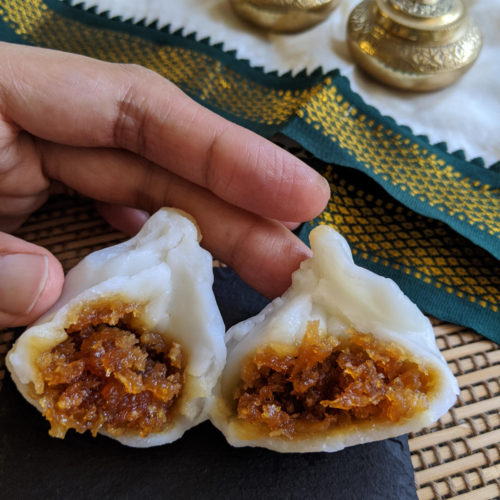
Super soft modaka and kadubu using rice
Rice, coconut and jaggery dumplings made from scratch using rice instead of rice flour!
Equipment
- I use standard measuring cups to measure ingredients in my recipes.
- Steamer
- blender/mixer-grinder
Ingredients
For filling
- ¾ cup grated coconut fresh or frozen
- ½ cup jaggery grated/powdered. Adjust to your sweetness
- ¼ tsp cardamom powder adjust based on liking
For outer rice cover
- ½ cup white rice I use sona masoorie variety
- ¾ cup water
- ¼ tsp salt
- 1 tsp coconut oil optional
Jaggery-free filling option, skip if preparing with jaggery
- ½ cup grated coconut fresh/frozen
- ½ cup dates paste blended coarsely without adding water
- 2-4 tbsp roasted nuts finely chopped
- ¼ tsp cardamom powder adjust to taste
Instructions
Soak rice
- Wash rice well, until water runs clear.
- Soak rice in water for at-least 5 hours or overnight. Continue with following steps after rice is soaked.
Prepare the filling.
- Defrost coconut if using frozen.
- In a pan, heat the coconut and jaggery until jaggery melts and excess liquid evaporates. This step ensures that jaggery does not melt and drain out of modaka when they are being steamed.
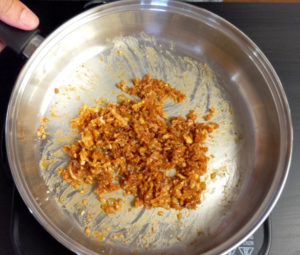
- Add cardamom powder and mix. Set aside.
Jaggery-free filling, skip this step if preparing the filling using jaggery.
- Mix together all the ingredients listed under Jaggery-free filling option.
Prepare the rice dough
- Drain the soaked rice and blend into a smooth paste. The batter should not be gritty. Use water as needed from the ¾ cup mentioned in the ingredients.
- Transfer the batter to a thick bottomed pan. Add the remaining water, oil and salt.
- On medium heat, keep stirring the mixture until it comes together in a lump. On checking, you should be able to form balls with wet or greased hands. Note: It is important to continuously stir the batter.
- Turn off the heat and transfer to a plate. Keep the dough covered until temperature reduces enough to be handled. (It has to be kneaded when still warm)
- With wet hands start kneading the dough. Hands can also be greased with oil or ghee to prevent sticking. Keep kneading until it forms a smooth dough.
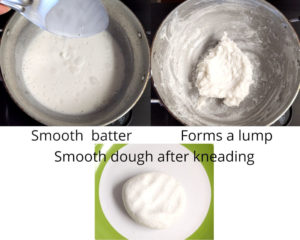
- Make equal sized balls. I made 7. It is important to keep them covered so they do not dry out.
Shaping modaka
- Flatten the balls into a circle of about 5 inches in diameter. A tortilla press/papad press can be used. Can also be flattened using greased palm and fingers.Or keep the dough ball between two pieces of parchment/plastic and press using a heavy pan.
- Place about 1 tbsp of the sweet filling in the center.
- Make pleats on the edges of the circular disk and bring the sides together to the top, to seal it well. Please check the video above for a visual tutorial.
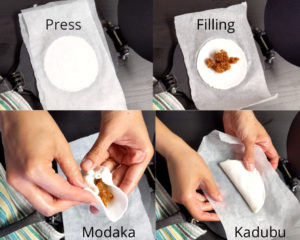
Shaping kadubu
- Flatten the balls into a circle of about 5 inches in diameter. A tortilla press/papad press can be used. Can also be flattened using greased palm and fingers.
- Fold the flattened rice disk to form a semi-circle/half moon shape.
- Seal the edges well. Wet fingers if needed to help it seal well..
- Optionally, a pleated design can be made at the edges of kadubu. Please check the video for a visual tutorial.
Steaming modaka and kadubu
- Get a steaming apparatus ready with water boiling.
- Optionally place banana leaf/turmeric leaves over the steamer holes.
- Place the modakas and kadubu in the steamer.
- Wrap the lid in a kitchen towel to prevent condensation.
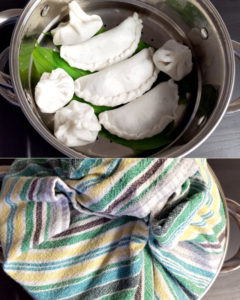
- Steam for 20 minutes on medium heat.Note: You should be able to see some steam coming out of the steamer, or the heat is too low.
- Enjoy modaka with a dollop of ghee on top.
Video
Notes
- When adjusting the sweetness of filling to your liking, do keep in mind that the outer cover is not sweetened. So, the filling will need to be sweeter than what you want in the final dessert.
- Wet your hands while kneading. Prevents the dough from sticking.
- Keeping the dough covered is important to ensure they do not dry.
- Hands can be greased while shaping modaks and kadubu to prevent sticking.
- Make sure that the shaped modaka and kadubu are properly sealed.
- If doubling the recipe, make sure not to overcrowd the steamer, so that steam can circulate easily and the modaks cook evenly.